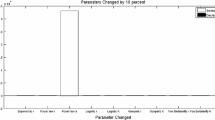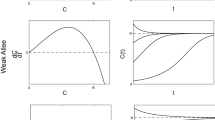Abstract
Sigmoid functions have been applied in many areas to model self limited population growth. The most popular functions; General Logistic (GL), General von Bertalanffy (GV), and Gompertz (G), comprise a family of functions called Theta Logistic (\( \Uptheta \) L). Previously, we introduced a simple model of tumor cell population dynamics which provided a unifying foundation for these functions. In the model the total population (N) is divided into reproducing (P) and non-reproducing/quiescent (Q) sub-populations. The modes of the rate of change of ratio P/N was shown to produce GL, GV or G growth. We now generalize the population dynamics model and extend the possible modes of the P/N rate of change. We produce a new family of sigmoid growth functions, Trans-General Logistic (TGL), Trans-General von Bertalanffy (TGV) and Trans-Gompertz (TG)), which as a group we have named Trans-Theta Logistic (T \( \Uptheta \) L) since they exist when the \( \Uptheta \) L are translated from a two parameter into a three parameter phase space. Additionally, the model produces a new trigonometric based sigmoid (TS). The \( \Uptheta \) L sigmoids have an inflection point size fixed by a single parameter and an inflection age fixed by both of the defining parameters. T \( \Uptheta \) L and TS sigmoids have an inflection point size defined by two parameters in bounding relationships and inflection point age defined by three parameters (two bounded). While the Theta Logistic sigmoids provided flexibility in defining the inflection point size, the Trans-Theta Logistic sigmoids provide flexibility in defining the inflection point size and age. By matching the slopes at the inflection points we compare the range of values of inflection point age for T \( \Uptheta \) L versus \( \Uptheta \) L for model growth curves.












Similar content being viewed by others
References
Bajzer Z, Carr T, Josic K, Russell S, Dingli D (2008) Modeling of cancer virotherapy with recombinant measles viruses. J Theor Biol 252(1):109–122
Fokas N (2007) Growth functions, social diffusion and social change. Rev Soc 13:5–30
Katsanevakis S (2006) Modelling fish growth: model selection, multi-model inference and model selection uncertainty. Fish Res 81:229–235
Kozusko F, Bourdeau M (2007) A unified model of sigmoid tumour growth based on cell proliferation and quiescence. Cell Prolif 40:824–834
Kozusko F, Bourdeau M, Bajzer Z, Dingli D (2007) A microenvironment based model of antimitotic therapy of Gompertzian tumor growth. Bull Math Bio 69:1691–1708
Lotka AJ (1925) Elements of physical biology. Williams & Wilkins, Baltimore
Acknowledgments
We thank Dr. Zeljko Bajzer, Biomathematics Resource, Mayo Clinic College of Medicine, Rochester, MN, USA for his review and helpful comments.
Author information
Authors and Affiliations
Corresponding author
Appendix
Appendix
1.1 Appendix A. Alternate PQ Model
Figure 13 presents the block diagram for the alternate PQ model where the new members produced by the P population initially join the Q non reproducing population. This model could be applied to any population where new members, such as human and animal populations, must mature before being capable of reproducing. Additionally, when the reproducers age, they again become members of the Q population.
Rate analysis of Fig. 13, produces the following rate equations:
where m = β − μ P + μ Q > 0 and the analysis follows as from Eq. 10. We should note that the form of \( \Uppsi \left( {{\raise0.7ex\hbox{$P$} \!\mathord{\left/ {\vphantom {P N}}\right.\kern-\nulldelimiterspace} \!\lower0.7ex\hbox{$N$}}} \right) \) here will be different than that in Fig. 2.
1.2 Appendix B. Derivations of Equations 12 and 15
Differentiating Eq. 1 and using Eq. 1 for the value of \( \left( {{\raise0.7ex\hbox{$N$} \!\mathord{\left/ {\vphantom {N {N_{\infty } }}}\right.\kern-\nulldelimiterspace} \!\lower0.7ex\hbox{${N_{\infty } }$}}} \right)^{\theta } \) yields
Using the value of \( \left( {{\raise0.7ex\hbox{${\dot{N}}$} \!\mathord{\left/ {\vphantom {{\dot{N}} N}}\right.\kern-\nulldelimiterspace} \!\lower0.7ex\hbox{$N$}}} \right) \) from Eq. 11 produces Eq. 12.
We derive Eq. 15, by first differentiating Eq. 11.
Using Eq. 14 for the right side of Eq. 29 and substituting for \( \left\{ {\left( {{\raise0.7ex\hbox{$P$} \!\mathord{\left/ {\vphantom {P N}}\right.\kern-\nulldelimiterspace} \!\lower0.7ex\hbox{$N$}}} \right) - \left( {{\raise0.7ex\hbox{$P$} \!\mathord{\left/ {\vphantom {P N}}\right.\kern-\nulldelimiterspace} \!\lower0.7ex\hbox{$N$}}} \right)_{\infty } } \right\} \) from Eq. 11 produces
The chain rule provides the substitution \( \frac{d}{dt}\left( {{\raise0.7ex\hbox{${\dot{N}}$} \!\mathord{\left/ {\vphantom {{\dot{N}} N}}\right.\kern-\nulldelimiterspace} \!\lower0.7ex\hbox{$N$}}} \right) = N\left( {{\raise0.7ex\hbox{${\dot{N}}$} \!\mathord{\left/ {\vphantom {{\dot{N}} N}}\right.\kern-\nulldelimiterspace} \!\lower0.7ex\hbox{$N$}}} \right)\frac{d}{dN}\left( {{\raise0.7ex\hbox{${\dot{N}}$} \!\mathord{\left/ {\vphantom {{\dot{N}} N}}\right.\kern-\nulldelimiterspace} \!\lower0.7ex\hbox{$N$}}} \right) \) that transforms Eq. 30 to Eq. 15.
Rights and permissions
About this article
Cite this article
Kozusko, F., Bourdeau, M. Trans-Theta Logistics: A New Family of Population Growth Sigmoid Functions. Acta Biotheor 59, 273–289 (2011). https://doi.org/10.1007/s10441-011-9131-3
Received:
Accepted:
Published:
Issue Date:
DOI: https://doi.org/10.1007/s10441-011-9131-3





